Table of contents
- Euro 3 and Euro 4 measurements Silencers really are that loud
- Is Euro 4 quieter than Euro 3 at all?
- The test candidates
- Driving noises according to Euro 4
- MOTORRAD conclusion on Euro 4 measurements
- Driving noises according to Euro 3
- MOTORRAD conclusion on Euro 3 measurements
- Realistic assessment of the driving noise
- MOTORRAD conclusion on practical measurements
- Performance and stationary noise measurements
- Buy rear silencer here
- This is how MOTORRAD tests
- Interview with the TuV expert
Motorcycle noise
Debate about the volume of motorcycles

Jorg Lohse
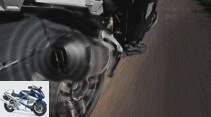

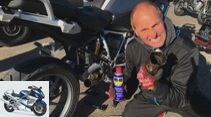
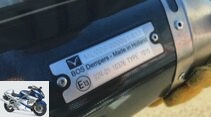
16 pictures
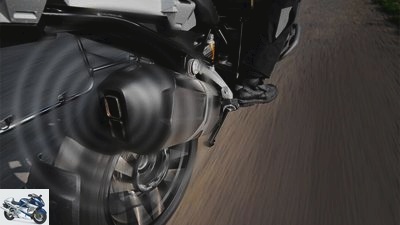
Jorg Lohse
1/16
Exhaust practical test Euro 3 vs. Euro 4.

Jorg Lohse
2/16
It’s on: a new silencer is mounted on the GS within a few minutes.
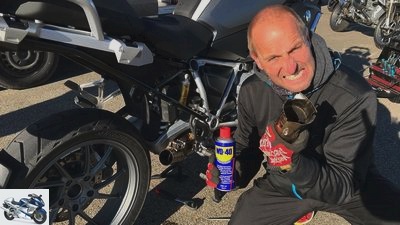
Jorg Lohse
3/16
It’s off: Sometimes you have to be a little more ruthless when screwing outdoors.
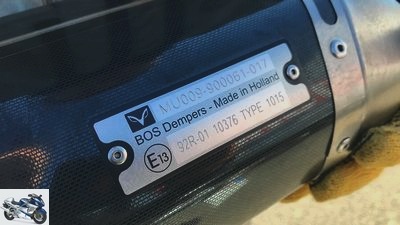
Jorg Lohse
4/16
Fit for Euro 4…
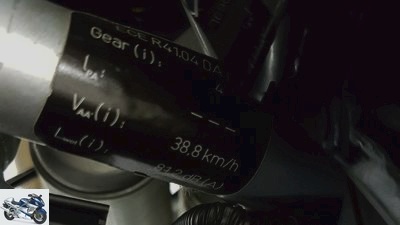
Jorg Lohse
5/16
…Motorcycle marked according to the new ECE regulation and homologated accessory silencer.
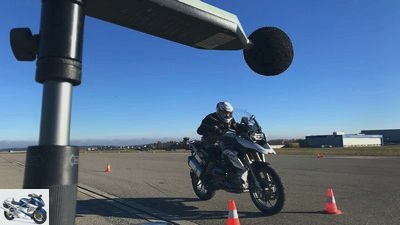
Jorg Lohse
6/16
Tempo 50, second and third gear, tap on. Pretty hairy to stay below 80 decibels on average.
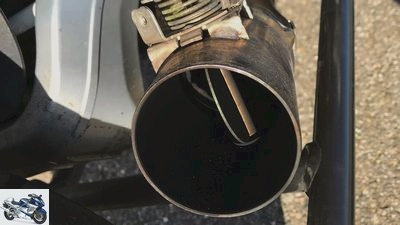
Jorg Lohse
7/16
Tricked: There is no flap designed for the MOTORRAD method.
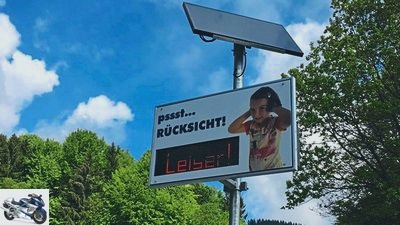
Antenna Bavaria
8/16
Promising pilot project: Actively controlled “noise signs” can actually noticeably reduce noise pollution.
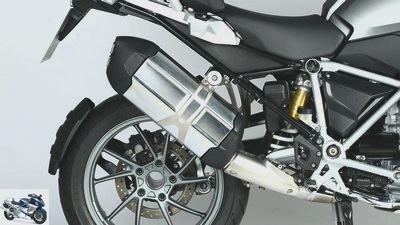
mps photo studio
9/16
BMW Original (Euro 4).
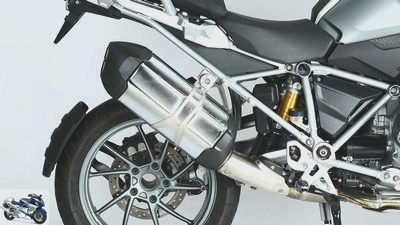
mps photo studio
10/16
BMW Original (Euro 3).
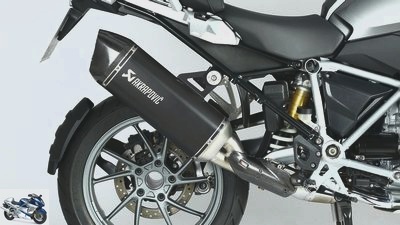
mps photo studio
11/16
Akrapovic Slip on (Euro 4).
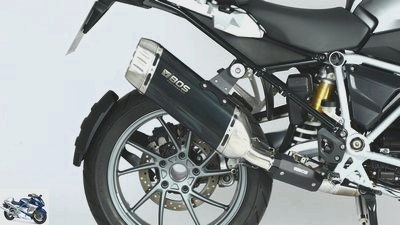
mps photo studio
12/16
Bos Desert Fox (Euro 4).
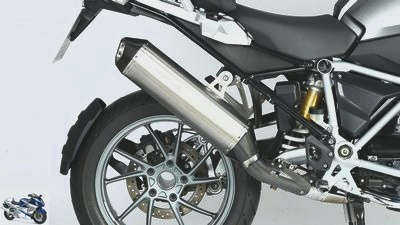
mps photo studio
13/16
Remus Black Hawk (Euro 4).
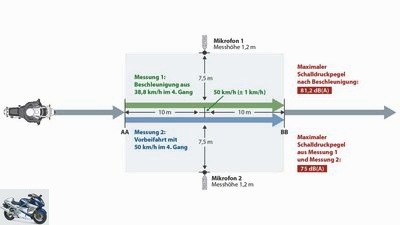
MOTORCYCLE
14/16
Euro 4 driving noise measurement for BMW R 1200 GS.
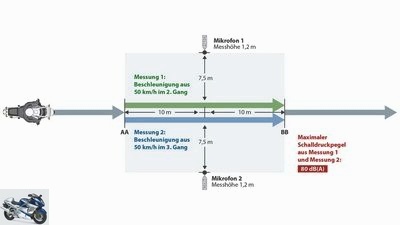
MOTORCYCLE
15/16
Euro 3 driving noise measurement in general.
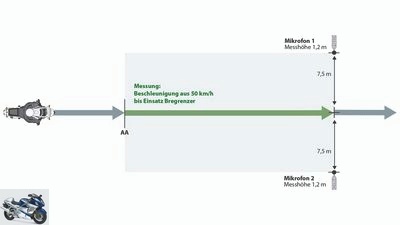
MOTORCYCLE
16/16
MOTORCYCLE method driving noise measurement for BMW R 1200 GS.
motorcycles
Exhaust volume according to Euro 3, Euro 4 and real perception
Euro 3 and Euro 4 measurements
Silencers really are that loud
Route closures, driving bans, outbursts of anger. Hardly any of our scenes can escape the stigmatization of the motorcycle as a riot machine. Can the new noise limit of 77 decibels create conciliatory tones? The ultimate exhaust practice test: Euro 3 vs. Euro 4.
Jorg Lohse
07.12.2017
Experts rate the Noise Ordinance ECE-R41, which has come into force since Euro 4, as an important success in terms of noise protection: “We actually noticed a change in the noise level”, judges Paul Lohmar, homologation expert from TuV Rheinland in an interview with MOTORRAD. A certain political component must of course not be disregarded in the amendment to the ordinance. A striking reduction in the driving noise of 80 decibels, which was valid until the introduction of Euro 4, seemed to have been urgently required. With the new one, meaningfully as “urban” The sound pressure level of 77 dB (A) described at first sounded very promising.
Buy complete article
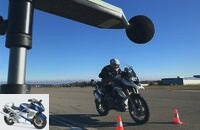
Euro 3 and Euro 4 measurements
Silencers really are that loud
8 pages) as PDF
€ 2.00
Buy now
Is Euro 4 quieter than Euro 3 at all?
It was all the more amazed to leaf through the measurement methodology of the new regulation to find that the old 80 decibels cannot be related to the new limit value at all. Motorcycles that were homologated to both Euro 3 and 4 and, despite being technically identical, were differently loud or quiet on paper, supported these doubts.
Which is how this practical comparison was set: How quiet has a Euro4 motorcycle actually become? Has it actually become quieter than Euro3? And are there perhaps methods with which loud and quiet bikes can be rasterized realistically and close to everyday life? If we now take a closer look at the motorcycles and accessory silencers, the test bench curves and stationary noise measurement already speak for themselves.
Because tuning by exhaust, that was once upon a time. Gone are the days when you could quickly and easily conjure up a performance increase of ten percent or even more on the test stand role by repositioning the muffler. In the meantime, the actual differences have almost leveled out. Essentially, the accessory muffler has to serve more as a visual gimmick nowadays, at the most when it comes to weight, there are still somewhat tangible and noteworthy differences compared to the series. On the dynamometer and with the stationary noises, you therefore stay almost at the level of the factory template. Which is related to the fact that the front silencer or firmly integrated flap systems have taken on important tasks. Which, in turn, does not mean that building exhausts has degenerated into a playful design of pipe bending. Technically, it remains a demanding task to design an exhaust in such a way that it works properly, does not cut any performance compared to the series and is also in accordance with the legal requirements.
The test candidates
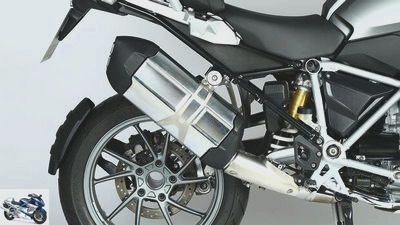
mps photo studio
BMW Original (Euro 4).
BMW Original (Euro 4)
Material: stainless steel
Weight: 4.9 kg
Country of manufacture: Poland
ECE test mark: 13 (Luxembourg)
Price: from 704.05 euros
Info: www.bmw-motorrad.de
Purchase opportunity: Motorcycle marketplace
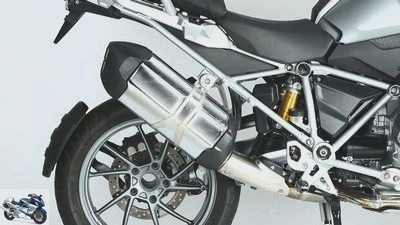
mps photo studio
BMW Original (Euro 3).
BMW Original (Euro 3)
Material: stainless steel
Weight: 4.9 kg
Country of manufacture: Poland
ECE test mark: 24 (Ireland)
Price: from 686.89 euros
Purchase opportunity: www.ebay.de
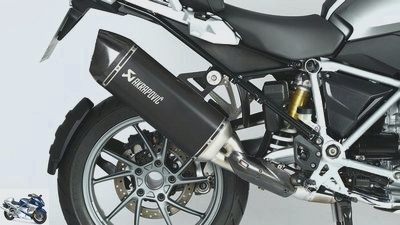
mps photo studio
Akrapovic Slip on (Euro 4).
Akrapovic Slip on (Euro 4)
Material: titanium
Weight: 4.6 kg
Country of manufacture: Slovenia
ECE test mark: 24 (Ireland)
Price: 1149 euros
Purchase option: www.louis.de
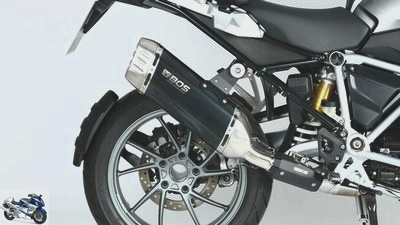
mps photo studio
Bos Desert Fox (Euro 4).
Bos Desert Fox (Euro 4)
Material: stainless steel
Weight: 4.3 kg
Country of manufacture: Netherlands
ECE test mark: 13 (Luxembourg)
Price: from 799 euros
Purchase option: www.louis.de
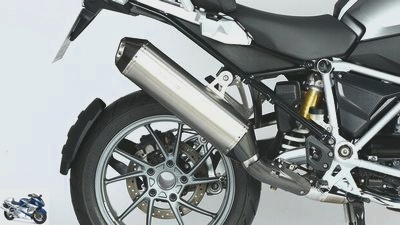
mps photo studio
Remus Black Hawk (Euro 4).
Remus Black Hawk (Euro 4)
Material: stainless steel
Weight: 3.1 kg
Country of manufacture: Austria
ECE test mark: 4 (Netherlands)
Price: 765 euros
Purchase option: www.ebay.de
Remus Black Hawk
buy on eBay
advertisement
Driving noises according to Euro 4
The distance: 20 meters. The speed: between 30 and 70 km / h. In this area, the legally relevant driving noises for the motorcycle are determined. At the end there has to be a decibel value that corresponds to little more than the noise of the wind on the ear. Euro 4-GS, accessory silencer and the Euro 3 sister model in comparison.
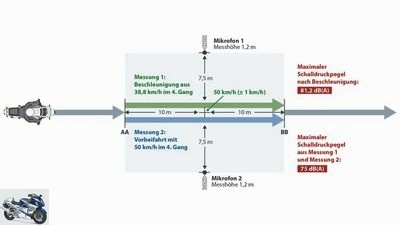
MOTORCYCLE
Driving noises according to Euro 4 for BMW R 1200 GS.
It is no easy exercise to determine the legally relevant driving noises according to the new ECE regulation R41. Gone are the days when people were generally lumped together. For each motorcycle there are now individual specifications that must also be attached to the vehicle. Our test BMW is registered with 75 dB (A) according to the approval documents. This decibel figure, which is referred to as L (urban), i.e. more or less noise value for urban traffic, cannot simply be measured like that. Our graphic illustrates the complexity of the new noise test method.
In case of R 1200 GS On the one hand, the accelerated drive past with an initial speed of 38.8 km / h in fourth gear over the 20-meter-long measuring section. When passing the AA line, the throttle grip is fully opened, at BB it is closed again. Important: When passing the center line (where the microphones are also positioned), the speed must be 50 km / h. This requirement is the same for all motorcycles, which is why it is now understandable that individual output values (speed, gear step) apply depending on the acceleration capacity of the respective bike. The maximum permissible decibel value, referred to as L (wot) in the acceleration measurement, is 81.2 dB (A) in the case of the GS. In order to determine L (urban), however, the second test point is still missing: driving through in the same gear at 50 km / h. Taking into account a motorcycle-dependent partial load factor, the driving noise now results from the constant sound pressure level L (crs) and acceleration value L (wot) using a formula calculation L (urban).
MOTORRAD conclusion on Euro 4 measurements
Pass an exam. Both the original BMW R 1200 GS and the muffler accessories available for it keep the noise level easily. 75 dB (A) are entered, and the off-road boxer would actually be Euro 4 compliant with two decibels more. But: The Euro 3-GS also easily takes this hurdle. The question arises: Have motorcycles become quieter??
| BMW Original (Euro 4) |
BMW Original (Euro 3) |
Akrapovic Slip on (Euro 4) |
Bos Desert Fox (Euro 4) |
Remus Black Hawk (Euro 4) |
|
| Driving noise | MOTORCYCLE readings | ||||
when accelerating,
L (wot) in dB (A)
L (crs) in dB (A)
Driving noises according to Euro 3
Athletes, tourers, choppers, crossers: Before the law, all bikes were the same with this measurement method. At least as far as the procedure is concerned. The driving noise is calculated from the average of various acceleration drives and not with an abstract formula. Is the Euro 4-GS a quiet step even in this test reality?
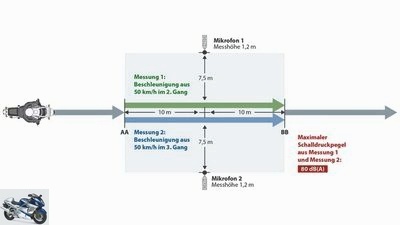
MOTORCYCLE
Driving noises according to Euro 3 in general.
This practice has passed into our flesh and blood in numerous exhaust tests in recent years. And a look at the diagram shows: In essence, the new Euro 4 regulation for determining the sound pressure level is based on the old European Directive 97/24 / EC. At least with regard to the general requirements for the location, the arrangement of the measuring section, the position of the microphones, but also the general test procedure. Our 2013 R 1200 GS, which now has to be compared with its Euro 4 sister, must not exceed a driving noise of 80 dB (A) according to the registration documents. In doing so, it also fully exploits the permitted framework. According to the law, it is not allowed to produce more sound pressure.
For comparison: The Euro 4-R 1200 GS with the entered 75 dB (A) still has room for improvement – 77 dB (A) would be allowed in its performance class. With the old driving noise measurement, the same starting conditions apply to all motorcycles, i.e. no individual, vehicle-dependent calculated values as before with the Euro 4 method. At 50 km / h, it goes into the test section in second gear, then accelerates 20 meters under full load. The same thing is repeated in third gear. The legally relevant driving noise is then calculated from the average values of all measurements. During our many exhaust tests, it was noticed that vehicle manufacturers (but also accessory providers) use special flap systems to reduce the driving noise “audible” could lower. No sooner had you reached 50 km / h in second or third gear than a flap in the manifold section closed and only opened again at around 80 km / h. Interestingly, the Euro 4-R 1200 GS also has the same valve control as its Euro 3 sister. Even without looking at the measuring instrument, it is clearly noticeable that the sound pressure level drops between 50 and 70 km / h in both boxers.
MOTORRAD conclusion on Euro 3 measurements
A picture as we know it from the past of our exhaust tests: The 80 decibels are almost impossible to lift. How some manufacturers can homologate this remains a mystery. But: Even the supposedly quieter Euro 4-GS fails on the 80 dB (A) hurdle.
| BMW Original (Euro 4) |
BMW Original (Euro 3) |
Akrapovic Slip on (Euro 4) |
Bos Desert Fox (Euro 4) |
Remus Black Hawk (Euro 4) |
|
| MOTORCYCLE readings | |||||
Driving noise
averaged in dB (A)
Realistic assessment of the driving noise
No partial load factors, no formula calculation of a fictitious sound pressure level for the urban environment. Finally, we give the boxers the spurs, as happens in many places in everyday life. This is of course far from any homologation, but much closer to the reality in which route closures and driving bans threaten.
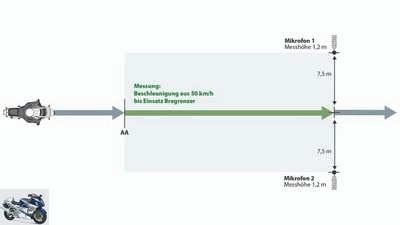
MOTORCYCLE
Driving noises according to our own and practical MOTORCYCLE measurement method.
Please imagine that you are sitting on your box and making a trip: Sunday morning, outskirts, the development is receding, you are targeting the winding country road. Three tippers down: second gear, full torque, turn off. Less than 50 meters behind the place-name sign, the engine roars in the vicinity of the limiter, so shift up, and you can continue at the standard highway speed. All in all, actually still harmless, but what if this process is repeated ten, 50 or even 100 times on a sunny day? It is understandable that the social acceptance of motorcyclists is on the brink, right??
In order to be able to compare the decibel values better, we carried out our own, practical and realistic test as a third measurement procedure. The test structure essentially follows the specifications that we already know from the Euro 3 and 4 exams. The only difference is that we are not now defining a fixed distance, but instead position the microphones for recording the sound pressure level where the motorcycles run into the limiter. So again, as with Euro 4, a method that is individually tailored to the respective bike and its acceleration capacity. The entry into the measuring section takes place in second gear at a constant 50 km / h, when passing the AA line the vehicle accelerates under full load. The MOTORCYCLE sound pressure level is now calculated from the average of various passages. Not an abstract urban value, but a realistic number that many residents on popular excursion routes, for example, have to live with in everyday life.
MOTORRAD conclusion on practical measurements
Welcome to reality. Whoever turns on the gas without considering, confronts his surroundings with a clear decibel plus even without an illegal roaring bag. Euro 3- and 4-GS don’t do anything. Although they differ significantly in their homologation values.
| BMW Original (Euro 4) |
BMW Original (Euro 3) |
Akrapovic Slip on (Euro 4) |
Bos Desert Fox (Euro 4) |
Remus Black Hawk (Euro 4) |
|
| MOTORCYCLE readings | |||||
Driving noise
2nd gear, limiter in dB (A)
Performance and stationary noise measurements
If there is a check at the roadside, a stationary noise measurement actually only provides information about whether an accessory exhaust has possibly been tampered with. There is no actual limitation of the stationary noises, which are measured at half the nominal speed at the exit height at a distance of half a meter at a 45-degree angle, even according to the currently valid Euro 4 regulations.
It is interesting that Euro 3 and 4 GS do not differ with the registered standing noises. The accessory pots are slightly louder, but this deviation would have to be booked under measurement tolerance. The scenario on the test bench is similar: the Euro 3 boxer does most of the work, followed by Euro 4 in its original version. With the accessory pots, the performance drops by less than three percent, together with the almost identical curve shape, this deviation can also be classified as insignificant.
| BMW Original (Euro 4) |
BMW Original (Euro 3) |
Akrapovic Slip on (Euro 4) |
Bos Desert Fox (Euro 4) |
Remus Black Hawk (Euro 4) |
|
| MOTORCYCLE readings | |||||
Driving noise
at 3850 rpm in dB (A)
Buy rear silencer here
| The rear silencers at a glance | Purchase opportunity |
| Original BMW | Order on eBay |
| Akrapovic slip on | Order at Louis.de |
| Bos Desert Fox | Order at Louis.de |
| Remus Black Hawk | Order on eBay |
This is how MOTORRAD tests
The former military airport in Neuhausen ob Eck fulfills the essential requirement: In addition to a wide asphalt surface, no sound-reflecting buildings in the vicinity of the route must falsify the measurement results. For this Euro 3 / Euro 4 practical comparison, a very fresh 2018 BMW R 1200 GS and the Euro 3-compliant model from 2013 were used. Three providers of already Euro 4 homologated accessory silencers round off our test drives, which are carried out according to the new Euro 4 standard, the old EU regulation 97/24 / EG and a completely new MOTORCYCLE standard.
Interview with the TuV expert
Paul Lohmar is the expert at TuV Rheinland when it comes to the homologation of motor vehicles. In an interview with MOTORRAD, he takes a position on the new noise regulation that came into force as part of Euro 4.
The new ECE regulation on the noise development of motorcycles reads complicated and seems extremely clauses. Couldn’t the topic have been solved more easily and more comprehensively?
No, because this regulation should contain the noise behavior of powerful vehicles. For the first time, the new regulation includes the recording and calculation of the curb weight and the performance of the vehicle in question. Motorcycles with a low curb weight and high performance have a harder time with these tests according to ECE-R41.04, as their acceleration is higher. Example: A motorcycle has an empty weight of 200 kg and an output of 150 kW. This results in a power-to-mass ratio, referred to as the PMR value, of 545. The prescribed reference acceleration is 4.95 m / s². On the other hand, for a vehicle which also has an unladen weight of 200 kg, but then only has 70 kW output, the prescribed reference acceleration of 3.85 m / s² with a PMR value of 255 applies. To put it simply: the motorcycle with a low curb weight and high performance gets off the spot faster. As a result, the speed increases suddenly, which results in higher noise behavior.
Euro 4 motorcycles can now be a maximum of 77 decibels loud when driving. Before that, a limit of 80 dB (A) applied. Our measurements raise doubts that the new motorcycles have actually become quieter. How are the experiences of TuV Rheinland?
Thats not really correct. Motorcycles that have been type-approved in accordance with the European Regulation VO (EU) 168/2013 must meet the noise requirements of Annex VI Part D. It says for two- and three-wheel vehicles with a displacement of up to 80 cm3: noise level maximum 75 dB (A). For motorcycles between 80 cm3 and 175 cm3 displacement, the noise level is a maximum of 77 dB (A) and for motorcycles over 175 cm3 a maximum of 80 dB (A). We also carried out reference measurements and were actually able to determine a change in the noise level in the vehicles presented to us. Manufacturers of high-performance, low-weight vehicles in particular now have to invest significantly more in the development of silencers in order to be able to comply with the noise levels.
One of the stated goals seemed to be that with the Euro 4, one wanted to exclude the use of flap systems that only make the motorcycle quieter in the legally relevant measuring range. Now there are still flap-controlled systems with Euro 4 approval – from the motorcycle manufacturers themselves and as accessories. A contradiction?
Yes and no, flap systems are expressly prohibited according to Regulation (EU) 168/2013 Article 19 only if the requirements specified therein are not met. However, if the engine can only be operated with this flap control for soundproofing and the engine would otherwise be damaged – a declaration from the manufacturer must be available to the technical service or the approval authority – or if additional tests have been carried out which include the scope of the flap control, are these allowed. Among other things, by the so-called ASEP test procedure, in which the measurement of noise emissions for vehicles that have different operating states is regulated. For example, flap controls or electronically controlled operating modes such as sport, race, etc. On the other hand, mechanical flap controls that can be operated by hand are partially prohibited. Unless they meet the conditions of Regulation (EU) 168/2013 Article 19 and Annex VI Part D..
Citizens’ initiatives are fighting against the flood of noise from motorbikes on popular excursion routes, which results in route closures. Would it even be possible to develop a noise standard that would let motorcyclists turn the gas with a good feeling and that would clearly identify the black sheep?
The ASEP test procedure is a first step in this direction, but it has to be further refined and, above all, consistently enforced. Lowering the noise level is the only real way to counteract this. However, there are limits here due to the small installation space and the current technical possibilities. In general, however, it is mainly up to the drivers themselves, as a matter of principle, they should adhere to Sections 1 and 30 of the StVO – i.e. be considerate and avoid unnecessary noise. However, since this review is very time-consuming and not consistently pursued, the aforementioned route closures are in place. Current attempts to measure the noise and display it to the drivers on a display board offer alternatives.
Related articles
-
Motorcycle noise Debate about the volume of motorcycles Kesstech counselor traffic & business Euro 4 and exhaust flaps Euro 4 and exhaust flaps…
-
www.jkuenstle.de 7th pictures Unger 1/7 After the tourist faction is well represented in the long-term test fleet with the Triumph Trophy and BMW GS, the…
-
A comparison test of ten silencers for the Kawasaki Z 800
mps studio 30th pictures Lohse 1/30 Certification mark: If the exhaust is correctly marked (E-check digit plus four-digit numerical code, 5 or 9 circled…
-
Exhaust test Yamaha FZS 1000 Fazer
Jahn accesories Exhaust & silencer Exhaust test Yamaha FZS 1000 Fazer Exhaust test Yamaha FZS 1000 Fazer Sound appeal 17 Accessory silencers for the…
-
Euro 5 for motorcycles from 2020
Katrin Sdun counselor traffic & business Euro 5 for motorcycles from 2020 Euro 5 for motorcycles from 2020 First exhaust gas values, then OBD II and…
-
Hertneck accesories Exhaust & silencer Exhaust test BMW K 1200 S Exhaust test BMW K 1200 S Investment advice When it comes to top performance, there is…
-
Motorcycle exhaust sound design
BMW accesories Exhaust & silencer Motorcycle exhaust sound design Exhaust special Sound hobbyist Content of The sound of our motorcycles is no…
-
Bikes that are no longer available with Euro 4 in 2017
Drawing: Aue 21 pictures www.bilski-fotografie.de 1/21 Aprilia SL 750 Shiver. www.factstudio.de, Joachim Schahl 2/21 BMW K 1300 S.. Ducati 3/21 Ducati…
-
Screwdriver tip exhaust system – Honda CB 750 Seven Fifty
Ralf Petersen 14th pictures Ralf Petersen 1/14 The starting point: a Honda CB 750 Sevenfifty for 850 euros, first registration February 1994. Ralf…
-
Tuning special – exhaust systems
Akrapovic 6th pictures Akrapovic. 1/6 Akrapovic has its own exhaust gas laboratory and its own titanium foundry for the direct implementation of new…